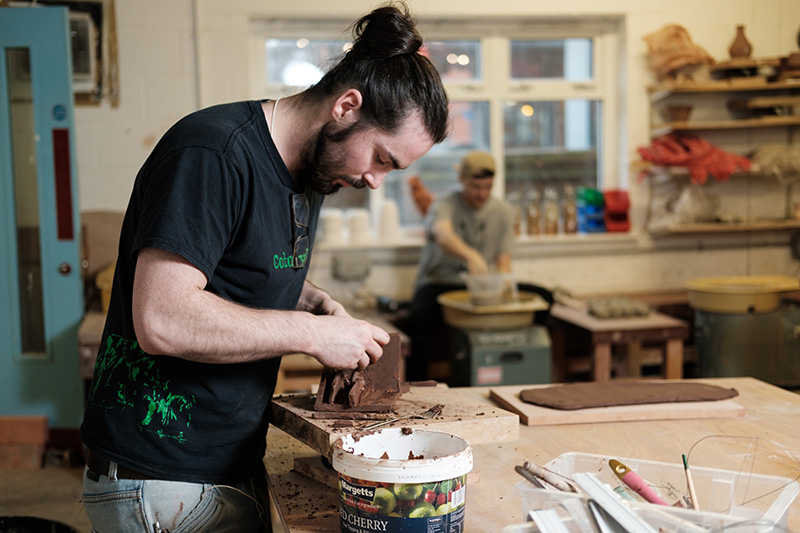Artists boost their practice through Wrexham Glyndwr University's Active Learning Framework

Artists at Wrexham Glyndwr University have discovered how the university’s learning blend can boost their practice in studio sessions – while keeping them safe.
Students at Glyndwr are being taught through the Active Learning Framework – known as ALF. The framework combines the best use of on-campus spaces – such as Glyndwr’s art studios and workshops on its Regent Street campus – with digitally-enhanced learning.
Among those who are studying though the framework are Applied Art students Bethan Parry, from Acrefair, who is the second year of her BA, and first year Natasha Hicks. Natasha, who is originally from Hong Kong, is currently living in Oswestry.
Both students have found themselves not only reassured about the safety of their workspaces, but also discovering new ways of learning – and the benefits of the Active Learning Framework.
Natasha said: “My tutors have done a good job in considering our health and safety, with face masks, social distancing, sanitising equipment and hand washing as a priority when on campus.
“I have found that the Active Learning Framework has given me the confidence to take ownership of my studies, as I have been able to refer to the pre-recorded videos that my tutors made as much as I like.
“I also feel fortunate to have a full workshop day on campus so I have the proper space to develop my skills with in-person support. First years have been lucky that the university have lent us basic toolboxes so we can bring essential tools home and continue our work from there.”
And Bethan added: “As with everything else in our COVID world, I think there was some trepidation about having to go outside and how teaching would work.
“However, the health and safety practices that were introduced in the university workshops were really reassuring, and I feel really privileged to be on a course where we are able to have a whole workshop day once a week.
“I’ve made a home workshop so I can do smaller pieces of work at home.
“The digital learning through our online guides has been great. We have all the techniques recorded and there is a quiz at the end to make sure we’ve understood.
“Our video meetings on a Monday are a great way of keeping connected with staff and peers, and for talking through any issues so that we are fully prepared for the techniques on our Friday workshop day.”
Bethan’s latest work has seen her devising jewellery pieces – and she has surprised herself by taking her work in new directions.
She said: “I initially applied to the applied arts course thinking I was going to work in ceramics but fell in love with metal.
“Our first semester piece this year was to create a commission or gift for an historical visionary, we were to research their lives and achievement and create an appropriate piece. I chose Virginia Hall, a WW2 spy and created a snake armpiece, after reading she had once worn live snakes as bracelets to school.”
Natasha’s latest work, meanwhile, has seen her develop pieces inspired by the natural world.
She said: “In my first semester we were introduced to metal and ceramics through the topic of ‘taxonomy’, we were required to select an example that sparked interest, and develop pieces based on it.
“I decided on evolutionary taxonomy after seeing a virtual exhibit on the Natural History Museum website about reindeer eyes, which change colour dependent on the seasons. I found the colour changes in relation to light levels fascinating and wanted to challenge myself as I had not worked with metal before, so I focused on lenses and apertures as well as the colour change - and made a functioning aperture by hand using brass.”
As she develops her pieces, the freedom offered through the Active Learning Framework – and the support being offered by her tutors, both face-to-face and online – has proved invaluable.
She added: “Having online content that I can revisit is something I have utilised often before workshop time - as it enables me to be prepared in advance and plan my workshop day accordingly.
“As a beginner this is extremely valuable so I can pause, rewind and really take the time to understand what I am being shown.
“Working with our tutors - Cerys, Julie and Wayne - has been an absolute joy. They are extremely organised and have worked hard to ensure we have everything we need, it really shows in the handbooks, videos, and short quizzes they have developed. I always feel like I have the support there if I need it regardless of if I am on campus or not, and I can tell they are passionate about their craft, which will influence my education positively.”
Bethan also welcomes the new opportunities Glyndwr’s learning blend has afforded her.
She added: “It’s been brilliant, I can watch them a few times to absorb the techniques - and I can rewind them if I’ve missed something that was said.
“I even rewatch on my phone in the university workshop while I’m trying the techniques - to make sure I’m doing them right.”
Applied Arts Programme Leader at Wrexham Glyndwr University, Cerys Alonso, said: “Artistic practice depends on a lot of hands-on work – so we knew we had to get it right when we were looking at our learning blend.
“So seeing students like Bethan and Natasha using their digital devices during our practical, on-campus sessions has been great.
“The Active Learning Framework helps us make the best use of that studio time, and not only keeps our students safe – it is actually helping them develop their practice. It’s definitely something we’re going to build upon as we move forwards.”